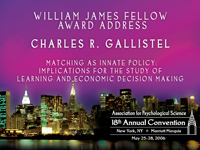Nature, Nurture, Nuance
Back in the day, if you studied environmental influences on behavior, it was easy to ignore the other thing — genes — in your work. By the same token, geneticists were happy to focus on biological inheritance and dismiss effects of environment as something far outside their purview.
But those days of “nature versus nurture” are over. What was once seen as a battlefield is starting to look more like a romance — nature wedded to nurture, the two inextricably intertwined and interdependent.
In his keynote address for the APS 18th Annual Convention, Sir Michael Rutter, King’s College, London, described a brave new world, often bewilderingly complex, of interplay between genes and environment that is being revealed by the emerging fields of behavioral and molecular genetics.
Twin and adoptee studies, for example, are showing strong inheritability of risk for psychopathology, he said, but also evidence that the actual levels of heritability vary by social context. By the same token, there is good evidence of environmental influences on most mental disorders … but also huge individual variation in response to the relevant environmental risks — meaning a major genetic component.
Molecular-genetic technology is allowing genetics to be “taken out of the black box of ‘something genetic,’” he said, such that it is increasingly possible to specify the actual effects of specific individual genes for susceptibility to mental disorders. However, again there is a caveat: The expectation that mental disorders would be the direct, straightforward result of abnormal genes needs to be set aside. Evidence shows that most mental disorders are caused by multiple genetic and environmental factors, that many genetic and environmental effects function dimensionally and not categorically — that is, they don’t work as simple “on-off” switches — and that many are caused by normal allelic variations (that is, the normal alternative forms taken by specific genes) and not by rare mutations.
In short, Rutter suggested, all these “buts” make it no longer possible to see genes and environment as two separate and separable influences on behavioral traits and mental disorders. The picture is much, much more nuanced.
The four types of gene–environment interplay that really matter, Rutter said, are: 1) the effects of different environments on the expression of genes, 2) environmental variations on gene heritability, 3) correlations between genes and environment, and 4) interaction between genes and environment.
First, the processes whereby genes get expressed — or not — are crucial. “Having a gene doesn’t do anything,” Rutter said, “until it is expressed.” And whether and how it expresses can be influenced by other genes, by the cellular environment, by environmental factors, and by chance. Gene expression also varies depending on the phase in an organism’s development.
Studies with rats have shown, for example, that differences in maternal nurturance produced differences in gene expression in offspring having to do with their stress responses. “The interest comes in indicating that although rearing experiences of a particular kind do not change the gene sequence … what they do is change gene expression and thereby alter gene effects.”
Heritability is the second important form of gene–environment interplay. Environment affects the heritability of traits such as mental illness, and several competing models have been proposed to explain how this works. Evidence so far is inconclusive, he said: It is too soon to tell whether a particularly strong environmental influence would outweigh genetic influences or whether a strong environmental influence would tend to be counterbalanced by enhanced genetic influences.
Gene–environment correlations, the third form of gene–environment interplay Rutter discussed, refer to how an individual’s genes influence how likely they will be to be exposed to certain environmental circumstances. For example, children behaviorally alter their rearing environments, and striking twin studies have shown that an adopted twin will evoke parenting behaviors in his or her adoptive parents that are similar to those experienced by a co-twin raised by the birth parents.
Genes affect environments via behavior, Rutter said. Thus, in the future, he said, research should not look for genes that influence environments directly, but rather seek to understand how genes influence behaviors that in turn shape environments.
The final area Rutter discussed – gene–environment correlations refers to genetically-influenced individual differences in sensitivity (as opposed to liability to exposure) to environmental risks. “For quite a long while, the general wisdom in behavioral genetics was that gene–environment interactions were so rare and so minor that they could, in effect, be ignored,” Rutter said. The emerging picture is quite different: “Far from being rare and minor, they’re likely to become major.”
Not only are such interactions likely the raw material for natural selection, he said, but there is a growing number of examples of such interactions being discovered in genetic and biological research. Rutter noted a large study in New Zealand, for example, that showed strong genetic influences moderating whether stressful life events and childhood maltreatment would lead to depression later on.
“It is,” Rutter said, “a particularly exciting period in which there have been accomplishments in showing the reality of genetic effects and the reality of environmental effects. But we have moved away from saying how much is genetic and how much is environmental because the answer is, in many cases … that it’s both. It is in the interdependence and coaction of the two that I suggest much of the action is likely to lie. And I think we will see some important gains that will aid theory, and will also aid practice, in the decades to come.




APS regularly opens certain online articles for discussion on our website. Effective February 2021, you must be a logged-in APS member to post comments. By posting a comment, you agree to our Community Guidelines and the display of your profile information, including your name and affiliation. Any opinions, findings, conclusions, or recommendations present in article comments are those of the writers and do not necessarily reflect the views of APS or the article’s author. For more information, please see our Community Guidelines.
Please login with your APS account to comment.